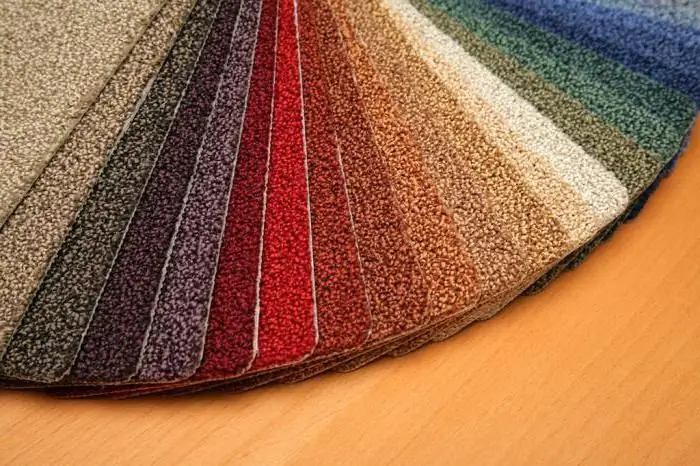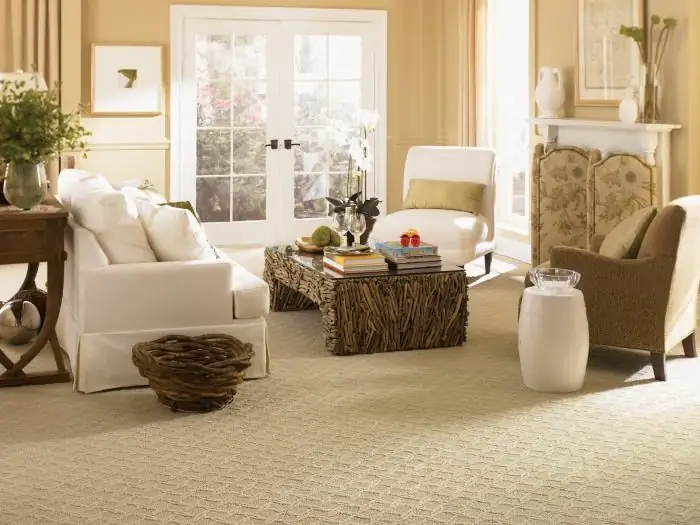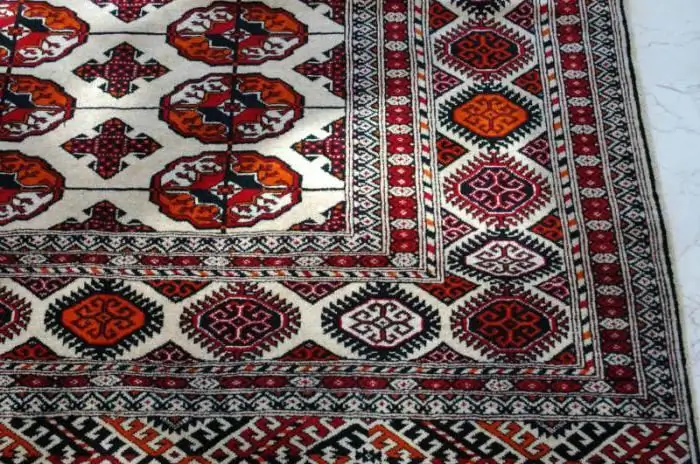2026 Author: Priscilla Miln | [email protected]. Last modified: 2025-06-01 05:14:29
The Turkmen carpet, which is also called Bukhara, belongs to the most popular family of handmade flooring products. Today it is a national symbol, officially approved. The ornament is placed on the flag of the state, the carpet is a national treasure, the country even approved Carpet Day. However, it is wrong to associate this product with the modern state. True - historical - carpet makers live not only in Turkmenistan, but also in modern Uzbekistan, Turkey, Tajikistan, and other countries of Central Asia. In a word, in the territories that previously belonged to nomadic tribes.

Meaning of carpets
The Turkmen carpet personifies the world for the local population, while the whole surrounding world is a carpet spread out before the astonished traveler.
For the first time this product appeared among nomads, settled peoples were not familiar with the processmanufacturing - they were engaged in silk weaving. The most ancient carpets were born in the Trans-Caspian desert - it was here that cattle breeders roamed. The women of these tribes created amazing patterns of weaving from the wool of sheep. Skillful carpet weavers weave patterned carpets without a sketch, they almost intuitively create the correct geometric patterns.
The Turkmen carpet was originally intended not so much for decoration as for warming the home. Soft, lightweight products are ideal for nomadic life. The we alth of the family was assessed by the presence of carpets and the quality of their manufacture. It was also important to have a rich horse blanket and harness for camels - these items testified to we alth. The Turkmen carpet was an important element of the dowry, its quality spoke of the bride's abilities.

Birth of carpets
Since ancient times, they were made on the simplest machine: the stakes were driven into the soil at a distance equal to the required dimensions of the product. Bars were fastened behind the pegs, between which the base was stretched. It is difficult to imagine that on an area of two palms (about a square decimeter), the carpet weaver manually knitted about eight thousand knots, cutting the threads, after which there was a pile of up to one and a half centimeters. Working for a whole month, one craftswoman is able to weave about 5 meters of carpet.
At all times, the main material from which the Turkmen carpet is made has been and remains wool. Many peoples, including the Turkmens, believed that mutton skin can restore lost he alth and increase strength. At a latertime, these amazing properties began to be attributed to sheep wool carpets. Even today, the cradle of a child is covered with felt or a small rug. A woolen thread is tied around the baby's wrists, which should protect the baby from the evil eye. The sick are wrapped in woolen products.

Patterns
Scientists believe that the Turkmen patterns on the carpet are the embodiment of the concept of the universe of the Turkmens. The most significant ornamental units are the steppes, which are well known to the nomad. The finely patterned border consists of elements resembling traces of various animals - this symbolizes distant lands where no man has ever been, only animals can roam there.
Especially interesting for historians are the items hung over doorways. They most clearly illustrate the concepts of nomads about the composition of the world. Ensi are made in the form of an arch, at the bottom of which there is no border - this demonstrates the transition from the natural world to the world of habitation. The ornament, consisting of three parts, means the interconnection of three worlds.
Reflection
Life, history, traditional art were reflected in the works of the Turkmen artist R. M. Mazel. Living in Ashgabat until the mid-1920s, he painted many paintings with oriental motifs, reproductions of which were included in his book-album "Carpet Tales".

Teke
In ancient times, these products were produced by various tribes. It differed not only in appearance, but also in functionality. Woolen products with clear patterns had features inherent in eachtribe. The most famous products are: Turkmen carpet with patterns of the Teke tribe, Salors, Yomud, Saryks. Until the beginning of the 20th century, mainly vegetable dyes were used - they made it possible to create carpets of saturated colors. Bukhara carpets are a symbol of prosperity and even power.
Modern carpet weaving
By the end of the 20th century, the manufacture of carpets has become a very important branch of the state economy. The most famous handmade product produced in Turkmenistan is a carpet, the area of which is 301 squares. It was made in 2001, two years later it was entered into the Book of Records.
Today you can find not only traditional ornaments, but also find carpets depicting famous personalities. For example, the museum has carpets with portraits of Yuri Gagarin, Lenin and the poet Makhtumkuli.

Turkmen Carpet Day
This holiday was officially recognized in 1992, since then it has been celebrated on the last Sunday of May. It is difficult for a person far from national culture to understand why such attention is paid to the work of weavers. However, just looking at the flag of the state, it is not difficult to understand that the carpet is indeed an important part of the culture - its ornament adorns the symbol of the country. For a long time, this woolen product has been the most significant thing in everyday life. In addition, the Turkmen carpet in the interior has always meant power and prosperity.
A big concert is being organized as part of the holiday. Celebrations, performances, concerts are held in theaters, on stages and evencarpet weaving enterprises.
The main celebrations are held at the Carpet Museum, located in the capital. The government is making every effort to make the holiday as fun as possible. Sometimes competitions for the best carpets are announced to stimulate creativity.
Museum of Turkmen carpet
To preserve and revive carpet weaving, the government initiated the creation of the Carpet Museum. This institution is the most important cultural center of the country. More than 2 thousand carpets are exhibited here, among which there are products with incredibly rare Turkmen patterns. So, in this museum you can see the smallest rug made for carrying keys. By the way, the carpets here are not only exhibited, but also restored. This task is very difficult, since there are about one and a half million knots per square meter of a work of art. Various specimens are constantly brought to the museum: employees find old items. Today the area of the museum is about 5 thousand square meters. Various conferences and forums are held here.

Carpet shop
The Bukhara carpet is reminiscent of quality wine - it only gets better with age. By purchasing it, you can start a tradition, passing it on to descendants from generation to generation. Grandchildren-great-grandchildren will be very grateful for such a gift, because by that time the cost of the carpet will be several times more expensive.
You can buy Turkmen products in one of the shops of Turkmenistan or in the market. True, it is not so easy to take a carpet out of the country,because it is a national treasure. A special permit is required, which is quite expensive. You will also need to pay for the weight of the goods when transported by plane.
The carpet store can also be found in our country, many offers are put up by online stores. When buying, it is desirable to require a certificate certifying the authenticity of the product. The cost of real carpets is quite high, depending on the name of the master who created it, the number of repeating ornaments on them, the length of the pile. On average, the cost per square meter of such a work of human hands reaches 300 dollars. However, there are also much more expensive products.
Recommended:
Developing mat for a child with their own hands - patterns, interesting ideas and recommendations

At present, a developing baby mat can be purchased at specialized children's stores. A lot of companies, different variations of its patterns, elements for development, color schemes tempt young parents to buy. But many mothers think about a do-it-yourself developmental rug, because this is an opportunity to choose natural materials, decorative elements for development, a manifestation of their imagination
The pattern of education is General patterns of education

Education is an important point that deserves special attention. Special educational programs help the teacher to form a harmoniously developed personality
Polypropylene carpet: reviews, advantages and disadvantages. Carpet on the floor

Tired of looking for your slippers near the bed in the morning? And without them in any way, the floor is cold! To make awakening easier and the room more comfortable, you can lay a carpet on the floor
Carpet: reviews and tips. Inexpensive carpet. Carpet with pile

Inhabitants of Russia with the advent of cold weather are faced with the problem of a cool floor in the apartment. This problem can be easily solved by covering the floor with carpet. Carpets have been known to mankind since ancient times. For several centuries, they were a luxury item in the homes of we althy citizens. But now everything has changed! Among the floor carpets, the leading position is occupied by the carpet covering
Tabasaran handmade carpet: photo

As you know, tea is made in India, cars are made in Germany, and magnificent hand-woven pile carpets, striking in the beauty of color combinations and patterns, are made in Tabasaran. In Dagestan, carpet weaving is considered the most widespread, in addition, one of the most ancient types of applied art. In this article, we will learn what Tabasaran handmade carpets are, the photos of which are given below

